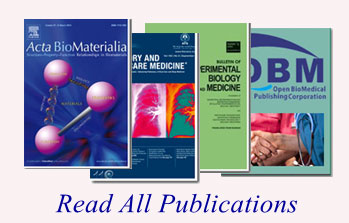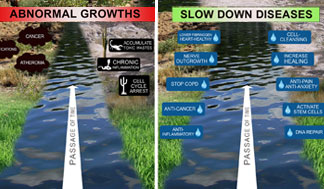by Loren Pickart, Discoverer of GHK and many of its biological effects
BA Chemistry and Mathematics, University of Minnesota
PhD Biochemistry, University of California, San Francisco
PUBLISHED OR REPORTED ACTIONS OF GHK:
The Broad Gene Institute found GHK induced a significant change in the gene expression, UP or DOWN, in 31.8% of the human genes. At levels of change greater than 50% UP or DOWN, it affected 4,192 human genes, dramatically affecting the following categories of concern:
| GHK was first studied for wound healing (1983+) and later for its effects on skin and hair. In many controlled, peer-reviewed published articles, GHK was found to: |
|
|---|---|
| • Topped 1,309 bioactive compounds as Broad Institute computer recommended molecule for treatment of Chronic Obstructive Pulmonary Disease. Restored healthy function in COPD affected cells at 10 nanomolar • Protected lung cells from damage by both bleomycin and lipopolysaccharide-induced injury • In fetal lung cells, GHK-Cu produced dose-response changes in 329 human fetal lung genes of the extracellular matrix |
• Completely blocked Cu2+ oxidation of low density lipoproteins while SOD1 gave only 20% blocking • Blocked release of oxidizing iron from ferritin |
| • Altered expression of human genes important in neuron function by 50%, plus or minus, with 408 UP and 230 DOWN • Induced strong anti-anxiety and anti-aggression effects in rats within 12 minutes at a weight equivalent of 35 micrograms in 70 Kg humans • Alleviated neuronal apoptosis due to intracerebral hemorrhage • Now used clinically in humans for the treatment of damaged spinal segments in the neck. Treatment for two months is daily injection of 7 mgs GHK-Cu into the skin around the damaged area. The cost of GHK-Cu is less than $0.01 a milligram |
• Enhanced activity of alginate hydrogels for human cord blood MCS stem cell osteogenesis
ADDITIONAL ACTIONS OF GHK: • Strongly chemo-attracted capillary cells, mast cells, and macrophages • Suppressed the insulin and insulin-like system that reduces lifespan in roundworms • Reduced fibrinogen synthesis. Fibrinogen levels are the top predictor of cardiovascular heart disease • Increases myostatin gene expression 9.4 fold. Myostatin inhibits heart failure. |
Where Did GHK Come From? What Does GHK Do?
GHK appears to part of a previously unknown system that adjusts the body to a "state" best suited for certain conditions such a good health, pregnancy, growth, cold weather, starvation, infections, aggression (to fight off animal attacks), etc. GHK is too small to carry any significant information. So the general pattern of gene expression of UP or DOWN must be present in the genes by modifications of proteins and RNA around the gene. Then GHK intensifies the effect. There must be several of such signals in addition to GHK.
GHK probably originated from an ancient marine protective system that protected cells against free, toxic copper and was swept into mammals on the tides of evolution. It predates modern growth factors and cytokines. GHK aids the differentiation of Ascaris suum roundworms. Roundworms are one of the most ancient animals arriving about 1 billon years ago. Barnacles date back 400 million years and GHK promotes their differentiation and settlement on surfaces.
One of the questions people ask is, how can GHK have such diverse actions such as healing, anti-cancer, anti-anxiety, COPD cell repair, etc? The answer is simple—during the course of evolution various genes became associated with various peptides, proteins, and RNA molecules that modulate their expression for optimal animal survival.
By Loren Pickart, PhD
GHK and DNA: REDUCING THE DISEASES OF HUMAN AGING
This information is for the use of medical researchers and persons interested in health sciences. It must be emphasized that GHK and other copper binding peptides have not been tested and approved for the treatment of human diseases.
The primary cause of human aging and its attendant diseases are changes in the activity of the human genome. During aging there is an increase in the activity of inflammatory, cancer promoting, and tissue destructive genes plus a decrease in the activity of regenerative and reparative genes.
Regenerative copper peptides appear to help maintain wellness and youth. The human peptide GHK induces a plethora of health associated actions such as tissue repair, anti-inflammatory actions, anti-cancer effects, anti-infection, stem cell activation, increasing protein P63, and so on. Gene data from the Broad Institute indicates that GHK controls or strongly influences 31.8% of the human genes - increasing the output in 59%, and reducing it in 41%, of the genes.
 In 2010, The Broad's Connectivity Map predicted that GHK, at a low and non-toxic level, would reverse the effects of aggressive, metastatic human colon cancer on 38 critical cancer-spreading genes. Specifically, it found that the cancer was suppressing genes used to kill cancer cells; the programmed cell death apoptosis system. Cells have "checkpoints" to determine if DNA is made properly and if it is not, the programmed cell death system terminates the cell. Recently, it was found that GHK did not harm certain normal cells, but acted reset the programmed cell death in human cancer cells and inhibit their growth. GHK-Cancer
In 2010, The Broad's Connectivity Map predicted that GHK, at a low and non-toxic level, would reverse the effects of aggressive, metastatic human colon cancer on 38 critical cancer-spreading genes. Specifically, it found that the cancer was suppressing genes used to kill cancer cells; the programmed cell death apoptosis system. Cells have "checkpoints" to determine if DNA is made properly and if it is not, the programmed cell death system terminates the cell. Recently, it was found that GHK did not harm certain normal cells, but acted reset the programmed cell death in human cancer cells and inhibit their growth. GHK-Cancer
In 2012, the Connectivity Map indicated that GHK would shift the gene output in severe emphysema in chronic obstructive lung disease (COPD) and shut down tissue destructive genes while increasing the output of genes associated with tissue healing and remodeling. This prediction was confirmed when tested on cells from patients with the disease where GHK, at a very low and non-toxic level, shifted the cellular genes patterns from tissue destruction to tissue repair. GHK-Emphysema
The Holy Grail of genome research is resetting the genes for health. GHK appears to do this on a wide range of tissues and diseases. Since GHK was originally isolated as a factor high in young persons but that declines with age, it is also possible that the molecule might restore humans to a biologically younger state.




















